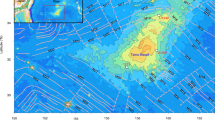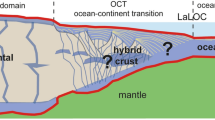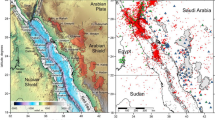Abstract
Continental breakup is usually marked by a sharp contact between continental and oceanic crust. However, in settings with low magma supply, this transition zone is much wider1,2 and exhibits a gradual change from continental crust, to exhumed blocks of continental mantle, to oceanic crust. Traditionally, the timing and location of continental breakup is defined by the first observation of a magnetic anomaly that is generated by magma erupted from the newly formed mid-ocean ridge. As the magma cools to form rock, it preserves a record of the Earth’s magnetic field at that time. However, in the broad transitional zone at magma-poor rifted margins, the seafloor-spreading origin of magnetic anomalies is debated3,4. Here we compare seismic5,6,7,8,9,10 and drill-hole data11,12,13 with measurements of the first magnetic anomaly—the J anomaly—formed in the Newfoundland–Iberia rift system. We find that the J anomaly is associated with locally high topography and thickened crust, probably resulting from voluminous magma both erupted at the surface and added beneath blocks of exhumed continental mantle. We therefore argue that the J anomaly did not form during seafloor spreading, but instead represents a pulse of magmatism that may have triggered continental breakup before seafloor spreading. Our findings imply that opening of this part of the North Atlantic may have occurred later than previously thought and may explain inconsistencies in some previous kinematic reconstructions.
This is a preview of subscription content, access via your institution
Access options
Subscribe to this journal
Receive 12 print issues and online access
$259.00 per year
only $21.58 per issue
Buy this article
- Purchase on Springer Link
- Instant access to full article PDF
Prices may be subject to local taxes which are calculated during checkout




Similar content being viewed by others
References
Boillot, G. et al. Ocean–continent boundary off the Iberian Margin: A serpentinite diapir west of the Galicia Bank. Earth Planet. Sci. Lett. 48, 27–34 (1980).
Whitmarsh, R. B., Manatschal, G. & Minshull, T. A. Evolution of magma-poor continental margins from rifting to seafloor spreading. Nature 413, 150–154 (2001).
Funck, T. et al. Crustal structure of the ocean–continent transition at Flemish Cap: Seismic refraction results. J. Geophys. Res. 108, 2531 (2003).
Russell, S. M. & Whitmarsh, R. B. Magmatism at the west Iberia non-volcanic rifted continental margin: Evidence from analyses of magnetic anomalies. Geophys. J. Int. 154, 706–730 (2003).
Péron-Pinvidic, G., Shillington, D. J. & Tucholke, B. E. Characterization of sills associated with the U reflection on the Newfoundland margin: Evidence for widespread early post-rift magmatism on a magma-poor rifted margin. Geophys. J. Int. 182, 113–136 (2010).
Péron-Pinvidic, G., Manatschal, G., Minshull, T. A. & Sawyer, D. S. Tectonosedimentary evolution of the deep Iberia–Newfoundland margins: Evidence for a complex breakup history. Tectonics 26, TC2011 (2007).
van Avendonk, H. J. A., Lavier, L. L., Shillington, D. J. & Manatschal, G. Extension of continental crust at the margin of the eastern Grand Banks, Newfoundland. Tectonophysics 468, 131–148 (2009).
van Avendonk, H. J. A. et al. Seismic velocity structure of the rifted margin of the eastern Grand Banks of Newfoundland, Canada. J. Geophys. Res. 111, B11404 (2006).
Shillington, D. J. et al. Evidence for asymmetric nonvolcanic rifting and slow incipient oceanic accretion from seismic reflection data on the Newfoundland margin. J. Geophys. Res. 111, B09402 (2006).
Dean, S. M., Minshull, T. A., Whitmarsh, R. B. & Louden, K. E. Deep structure of the ocean–continent transition in the southern Iberia Abyssal Plain from seismic refraction profiles: The IAM-9 transect at 40° 20′N. J. Geophys. Res. 105, 5859–5885 (2000).
Jagoutz, O. et al. The rift-to-drift transition in the North Atlantic: A stuttering start of the MORB machine? Geology 35, 1087–1090 (2007).
Tucholke, B. E. & Sibuet, J-C. in Proceedings of the Ocean Drilling Program, Scientific Results, Vol. 210 (eds Tucholke, B. E., Sibuet, J-C. & Klaus, A.) 1–56 (Ocean Drilling Program, 2007).
Zhao, X., Turrin, B. D., Jackson, M. & Solheid, P. in Proc. ODP, Sci. Results, Vol. 173 (eds Beslier, M-O., Whitmarsh, R. B., Wallace, P. J. & Girardeau, J.) 1–34 (Ocean Drilling Program, 2001).
Srivastava, S. P., Sibuet, J-C., Cande, S., Roest, W. R. & Reid, I. R. Magnetic evidence for slow seafloor spreading during the formation of the Newfoundland and Iberian margins. Earth Planet. Sci. Lett. 182, 61–76 (2000).
Sibuet, J-C., Srivastava, S. & Manatschal, G. Exhumed mantle-forming transitional crust in the Newfoundland–Iberia rift and associated magnetic anomalies. J. Geophys. Res. 112, B06105 (2007).
Cannat, M., Manatschal, G., Sauter, D. & Péron-Pinvidic, G. Assessing the conditions of continental breakup at magma-poor rifted margins: What can we learn from slow spreading mid-ocean ridges? C. R. Geosci. 341, 394–405 (2009).
Sibuet, J-C., Srivastava, S. P. & Spakman, W. Pyrenean orogeny and plate kinematics. J. Geophys. Res. 109, B08104 (2004).
Gong, Z., Langereis, C. G. & Mullender, T. A. T. The rotation of Iberia during the Aptian and the opening of the Bay of Biscay. Earth Planet. Sci. Lett. 273, 80–93 (2008).
Souriau, A., Chevrot, S. & Olivera, C. A new tomographic image of the Pyrenean lithosphere from teleseismic data. Tectonophysics 460, 206–214 (2008).
Rabinowitz, P. D., Cande, S. C. & Hayes, D. E. in Initial Report of the Deep Sea Drilling Project Vol. 43 (eds Tucholke, B. E. & Vogt, P. R.) 879–885 (US Government Printing Office, 1979).
Tucholke, B. & Ludwig, W. Structure and origin of the J Anomaly Ridge, Western North Atlantic Ocean. J. Geophys. Res. B 87, 9389–9407 (1982).
Merle, R. et al. Evidence of multi-phase Cretaceous to Quaternary alkaline magmatism on Tore–Madeira Rise and neighbouring seamounts from 40Ar/39Ar ages. J. Geol. Soc. 166, 879–894 (2009).
Peirce, C. & Barton, P. J. Crustal structure of the Madeira-Tore Rise, Eastern North-Atlantic—results of a DOBS wide-angle and normal incidence seismic experiment in the Josephine Seamount region. Geophys. J. Int. 106, 357–378 (1991).
Georgen, J. & Lin, J. Plume-transform interactions at ultra-slow spreading ridges: Implications for the Southwest Indian Ridge. Geochem. Geophys. Geosyst. 4, 9106 (2003).
Reston, T. J. & Morgan, J. P. Continental geotherm and the evolution of rifted margins. Geology 32, 133–136 (2004).
Torsvik, T. H., Muller, R. D., Van der Voo, R., Steinberger, B. & Gaina, C. Global plate motion frames: Toward a unified model. Rev. Geophys. 46, RG3004 (2008).
Geldmacher, J. et al. Origin and geochemical evolution of the Madeira-Tore Rise (eastern North Atlantic). J. Geophys. Res. 111, B09206 (2006).
Pariso, J. E. & Johnson, H. P. Do layer 3 rocks make a significant contribution to marine magnetic anomalies? In situ magnetization of gabbros at Ocean Drilling Program hole 735 B. J. Geophys. Res. 98, 16033–16052 (1993).
Ogg, J. G. & Smith, A. G. in A Geological Time Scale 2004 (eds Gradstein, Felix M., Ogg, James G. & Smith, Alan G.) 63–86 (Cambridge Univ. Press, 2004).
Quesnel, Y., Catalan, M. & Ishihara, T. A new global marine magnetic anomaly data set. J. Geophys. Res. 114, B04106 (2009).
Acknowledgements
We thank T. Minshull, P. Miles, S. Dean, B. Whitmarsh and D. Shillington for providing published and unpublished data. We acknowledge Othmar Müntener for discussions on this work. The work was supported by the Action-Marges, the French margin program (CNRS-INSU), and is a contribution of the ANR project ‘Rift-to-Ridge’.
Author information
Authors and Affiliations
Contributions
A.B., D.S., G.M., G.P-P. and M.M. contributed to the interpretation of the data and to the magnetic modelling and wrote the paper.
Corresponding author
Ethics declarations
Competing interests
The authors declare no competing financial interests.
Supplementary information
Supplementary Information
Supplementary Information (PDF 1465 kb)
Rights and permissions
About this article
Cite this article
Bronner, A., Sauter, D., Manatschal, G. et al. Magmatic breakup as an explanation for magnetic anomalies at magma-poor rifted margins. Nature Geosci 4, 549–553 (2011). https://doi.org/10.1038/ngeo1201
Received:
Accepted:
Published:
Issue Date:
DOI: https://doi.org/10.1038/ngeo1201
This article is cited by
-
Mantle exhumation at magma-poor rifted margins controlled by frictional shear zones
Nature Communications (2022)
-
3D crustal-scale structure of the West Iberia margin: a novel approach to integrated structural characterization of passive margins
Marine Geophysical Research (2021)
-
Gravimetric and magnetic fabric study of the Sintra Igneous complex: laccolith-plug emplacement in the Western Iberian passive margin
International Journal of Earth Sciences (2018)
-
Lower plate serpentinite diapirism in the Calabrian Arc subduction complex
Nature Communications (2017)
-
Birth of an oceanic spreading center at a magma-poor rift system
Scientific Reports (2017)



